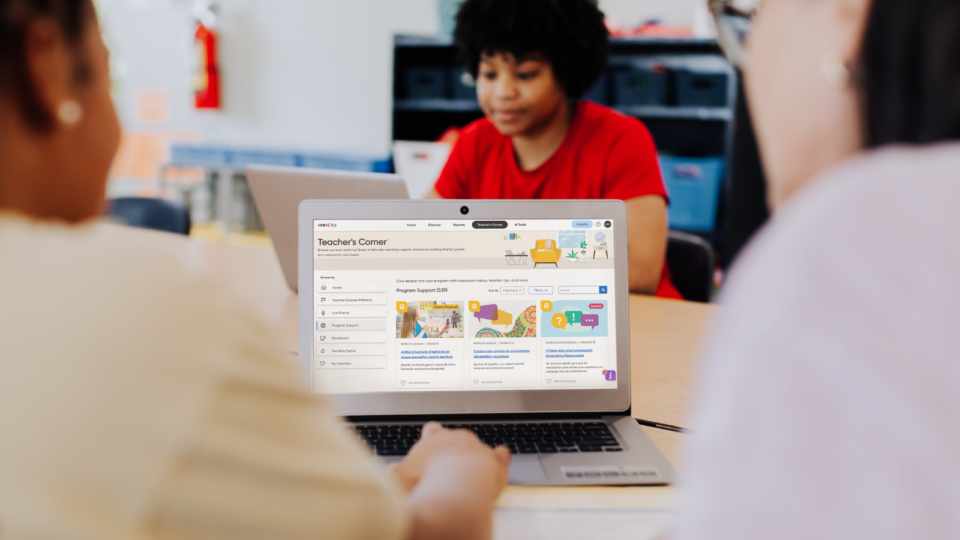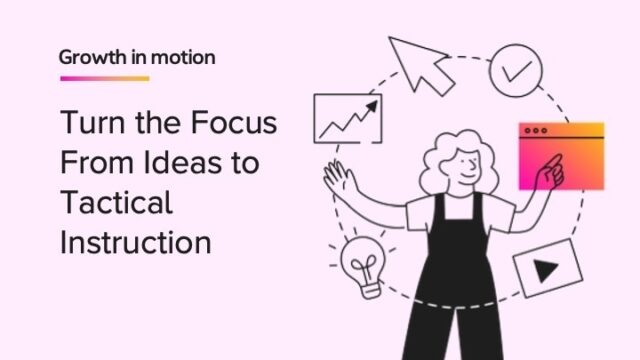
Five years ago, Teacher’s Corner launched with a bold mission: to make professional learning more accessible and authentic. It was built on the belief that teachers are most successful in helping their students grow when they control the path of their own professional learning. Teacher’s Corner is a professional learning space on Ed, HMH’s teaching platform, where educators can access short resources, watch classroom videos, and attend live sessions to support their instruction.
Becoming a community
What started as a concept to make support easily searchable and applicable for teachers has grown into a community with hundreds of thousands of educators who not only engage with these resources but also contribute to an ever-growing library by sharing materials, hosting live events, and inviting HMH into their classrooms to film lessons in action. The support extends beyond our platform with a Teacher’s Corner Facebook group of 75,000 members and counting, who share tips, answer questions, and let others know when there are product updates.
As we celebrate this milestone, we’re reflecting on the five biggest lessons we’ve learned—and how district and school leaders can apply these insights to strengthen their own professional development plans. And, if you’re a teacher reading this and agree with these insights, we encourage you to use this article as a reference when communicating feedback to teachers or administrators who are developing professional learning plans in your school or district.
1. Create bite-sized, practical content
With Teacher’s Corner, our goal from the onset was to ensure that the support was practical and immediately actionable. Although there are benefits to daylong in-person workshops or long asynchronously courses, we all know it’s hard to retain everything you learn. Over the years, “time commitment” has remained in the top 5 factors in evaluating PD opportunities and lack of time was cited as the number one reason for not completing a course. Too much time is spent on the theory and not enough time is spent on how to put the pedagogy into practice.
That might be why one of our most popular live event series is called “Make & Take” where teachers give 30-minute walkthroughs on resources they’ve created. This fall, we have Make & Takes for 5-minute student conferences, math center activities, writing lessons, and holiday letters from the classroom. In the video below, Kaci Dengler, an instructional specialist in Cypress Fairbanks ISD, shares how to make her Morphology Wall in a Make & Take session.
What we learned: Teachers prefer short, actionable resources they can use immediately. From quick videos to downloadable guides, Teacher’s Corner has prioritized content that respects teachers’ time, is specific to their instructional materials, and supports real classroom needs.
Administrator takeaway: When planning PD, opt for shorter formats, like 30-minute mini sessions, 15-minute videos, or even just a quick read. If you want the strategy or skill to be implemented well, offer more focus.
2. Ensure teacher-to-teacher learning
Teachers overwhelmingly prefer learning from peers who have taught the same curriculum, as it offers authentic, relatable strategies and helps solve real implementation challenges. In an early focus group, a seventh-grade teacher from New York told us, “Professional learning companies are great, but they often lack the in-the-trenches classroom experience.” We took that to heart and ensure that teacher-created content and perspectives were at the heart of the experience. We currently have 46 active teacher and leader contributors who have authored articles, recorded videos, hosted live sessions, and answered teacher questions for the Teacher’s Corner community. So, whether it’s watching a classroom video or hearing how another teacher introduced a new routine, we are witnessing how peer modeling is the best way to prepare teachers for success from day one.
Olga Fotinis is an instructional coach in New York City who created visual heart map templates, available in both in English and Spanish, as a way for students to synthesize what they've learned after engaging with an essential question and interacting in a set of texts or book. These templates contain a variety of guiding questions and phrases to help students think about what they learned, explore which themes struck a chord with them, and describe the characters they met and liked.

What we learned: Teachers overwhelmingly prefer watching real educators in real classrooms. They want model lessons to be authentic and within reach. Teachers prefer to hear from others who’ve taught their curriculum before to solve implementation pain points and inspire lesson extensions.
Administrator takeaway: Prioritize developing professional learning alongside lead or exemplary teachers and mix up who you select each time. Have teachers share videos from their classroom or leverage one from Teacher’s Corner’s growing library to spark discussion and strategy sharing. In Teacher’s Corner, we run 30-minute sessions called “Wait—Am I Doing This Right” where participants observe a lesson or routine and then discuss it and ask clarifying questions. This model has helped new teachers visualize the routine and feel comfortable asking questions.
3. Let teachers shape the focus
Teacher’s Corner was originally going to be called My Learning Playlist, with curated playlists of articles, videos, audio, and interactive media. This idea never came to fruition because teachers shared that they’d prefer to find and select the resources that were most helpful to them. We use the Teacher’s Corner online community to gather common questions and needs, using those to inform what content we create next. Sometimes quick responses from other teachers prompt longer format articles or sessions.
What we learned: Teachers have been instrumental in shaping Teacher’s Corner. We responded, for example, to their requests for more support with backwards planning or vocabulary resources. Engagement and participation are strongest when we design support based on their feedback.
Administrator takeaway: Create feedback loops in your PD strategy. Use surveys, focus groups, or informal check-ins to gather teacher input. Then act on it—whether it’s adjusting pacing, adding new topics, or improving access to resources.
4. Provide an on-demand pathway
In 2022, we extended Teacher’s Corner and developed Teacher Success Pathways, a series of short recordings, live sessions, and interactive media that helped teachers plan, teach, and assess with their program. Because many teachers receive district training before they have access to their curriculum or platform, it’s difficult to absorb and then apply what they’ve learned weeks later when they do get access. The pathways, always available via the Ed platform, guide teachers through planning, teaching, and assessing. The pathways have been tailored to each program and grade range, chaptered for quick access, and are always available to teachers. This back-to-school season, almost all teachers (97%) rated the pathways helpful.
What we learned: In every user research study we’ve conducted over the past six years, the majority of teachers reported a preference towards asynchronous PD. Teachers want to learn at their own pace, at the place and time of their choosing. Our Teacher Success Pathways get teachers up and running with their HMH programs. These chaptered recordings allow teachers to come back to a key routine or navigational path when they need to see it again.
Administrator takeaway: Incorporate opportunities for teachers to learn from the comfort of their own space and offer recordings of the most important learnings so that they’re easily referenceable. Make sure teachers know how to navigate recordings and qualify for certificates of completion. Provide the freedom to skip ahead or rewatch what they need and build in some time for reflection.
5. Name your PD program to build connection
After five years, Teacher’s Corner is a recognizable name among current and former educators. Teacher’s Corner is about giving teachers a space for learning, connecting, and reflecting. We designed Teacher’s Corner to have a big gold chair, a cozy blanket, and accessories like a laptop, coffee, water bottle. Redefining professional development as authentic, practical, and delightful continues to be critical to the brand’s success.

The gold chair has remained a central part of Teacher’s Corner’s identity. Through the year, there are different accessories displayed, but the gold chair remains a constant. Teachers wear their gold chair pins with pride and enjoy other fun giveaways.
What we’ve learned: Giving your professional learning program a name and look and feel, like “Teacher’s Corner” does more than brand it. It creates a shared identity that educators can rally around.
Administrator takeaway: Consider naming your school or district’s PD initiative. Whether it’s something aspirational or more community-driven and grounded in your values, a name can unify your team and make the program more memorable. Use it consistently across communications, events, and digital platforms to reinforce its presence and purpose.
Looking to the future
Teacher’s Corner has evolved because it listens to teachers, coaches, and administrators. As we look to the future, these five lessons will continue to guide our work. For school leaders, they offer a blueprint for designing PD that’s not just effective but also empowering. Leaders looking for support in fostering impactful instruction with HMH curriculum can find resources and events on their administrator Ed accounts in Leader’s Corner. There, education leaders can find instructional walkthroughs, data and reporting tutorials, and opportunities to hear from other leaders via live sessions, as well as access to all the resources in Teacher’s Corner.
***
Join HMH’s official Teacher's Corner Facebook group, a community of educators dedicated to on-demand professional learning and teacher support.
Get the eBook Building Your School Culture: An Administrator’s Guide today!














